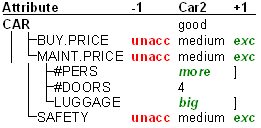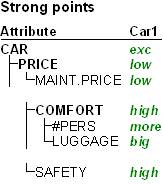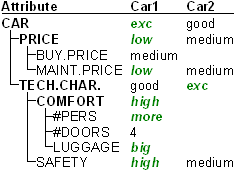Example: Some Car Option Analyses
This example shows some option analysis reports that can be obtained in DEXi using the Car Evaluation Model. These reports can be created by commands of the Analysis Menu or corresponding buttons on the Evaluation Page.
Plus-minus-1 analysis
This example shows results of “Plus-minus-1 analysis” for the option Car2 and the aggregate attribute CAR. The column Car2 displays the current values of Car2. The column -1 displays the values of the attribute CAR when each corresponding lower-level attribute’s value changes by one step down (independently of other attributes). Similarly, the column +1 shows the effects of increasing the value by one step up. Empty fields denote no effect, and the brackets ‘[’ and ‘]’ indicate that the attribute value cannot be decreased or increased, respectively.

The above display shows, for example, that BUY. PRICE considerably affects the evaluation of Car2. When BUY. PRICE decreases by one step (from ‘medium’ to ‘high’; the latter value is not shown), the overal value of CAR becomes ‘unacc’. In the other direction (from ‘medium’ to ‘low’), the overall evaluation improves to ‘exc’.
The two brackets ‘]’ indicate that the values of corresponding attributes, #PERS and LUGGAGE, cannot be increased any more, preventing the +1 part of the analysis.
Selective explanation
Selective explanation highlights particular advantages and disadvantages of an option. The method finds and displays only those connected sub-trees of attributes for which the option has been evaluated as particularly good or bad.

This example shows that Car2 has three particularly strong parts (two sub-trees and one single attribute):
overall evaluation, which is strongly influenced by low MAINT. PRICE,
COMFORT due to very good #PERS and LUGGAGE, and
high SAFETY.
Compare options
This analysis compares one (primary) option with some other selected (secondary) options, displaying all values of the primary option and only those values of the secondary options that differ from the primary’s ones.

This example compares Car1 (primary option) with Car2 (secondary option). Car2 differs from Car1 in the values of basic attributes MAINT. PRICE and SAFETY, which cause different evaluations of TECH. CHAR, PRICE and CAR.